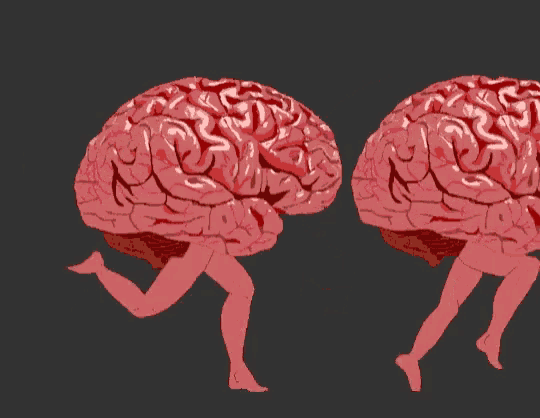Design thinking for amygdalae on the loose
I.
Numb and dissociated.
Angry and annoyed.
Chest tight, jaws clenched.
Fighting or fawning, freezing or in flight, out of here.
“We are amygdalae on the loose.”
That’s how Krista Tippet described us, our collective selves, in a recent OnBeing episode with Amanda Ripley.
And it resonated so much with me.
In a world of social media notification, constant text messages, the three dots of waiting responses, scam phone calls…
In a world of high social pressure to make money… with decreasing faith in our public institutions, decreasing access to public benefits, decreasing social safety nets…
In our highly individualized worlds, where we are more and more focused on the self and the nuclear family. Less focused on (despite more craving for) extended families and communities…
We really are amygdalae on the loose.
Our chest tight and b*tts clenched…
Or numb, disengaged, uninterested. Quietly quitting. Quietly everything…
Highly aware of movement around us…
Highly critical of others and ourselves…
Stuck in a binary of us vs. them in our work, in our values, in our politics…
The world is more and more designed to push us into our amygdala, our reptilian brain
So… how might we rethink our design practices in a world where we are amygdalas on the loose?
II.
A friend, Trauma Chaplain & Spiritual Care Coach, Abby Brockman, shared this story from psychologist Carl Rogers recently:
There comes to mind a psychologist whose interest in psychotherapy started as a result of his research in visual perception. In this research, many students were interviewed and asked to relate their visual and perceptual history, including any difficulties in seeing or reading, their reaction to wearing glasses, and so forth.
The psychologist simply listened with interest, made no judgments on what he was hearing, and completed the gathering of his data.
To his amazement, a number of these students returned spontaneously to thank him for all the help he had given them.
He had, in his opinion, given them no help at all.
But it forced him to recognize that interested non evaluative listening is a potent therapeutic force, even when directed at a narrow sector of life, and with no intent of being helpful.
As a design strategist, a facilitator and a coach, I have also experienced the potent, therapeutic force of non-evaluative listening again and again.
I have witnessed a simple act of listening with kindness, a simple act of validating people’s experience, a simple act of curiosity become a radical act of care in our loneliest, most uncertain moment of the pandemic.
In May 2020, a focus group on behalf of Harris County Judge’s Office with parents of young children on childcare during the pandemic ended with reflections like:
“I really thought I was alone. I’ve been so lonely as a mom. I care for my children but who is caring for me? Who is caring for us? But hearing others’ stories. I feel like we are in this together.
In June 2020, when I was testing out a public service application for the County on behalf of Connective, I kept hearing:
“Wow, I didn’t know the government actually cared. Thank you for asking for my opinions. I feel really heard!”
In December 2020, 1:1 interviews on finding work during the pandemic ended with participants saying:
“I didn’t even know this is what I was thinking and feeling. Thanks for helping me make some sense of this [early pandemic] time.”
I have seen first hand, the magic and potential of design as a space for care. I have experienced the design process - here, it was simply the research step - as an end in itself.
III.
When Sheila* joined our research call on Oct 18, 2022, it was just another day.
She’s a grandmother in her 60s, providing childcare out of her house to neighborhood kids since 2010. We started talking about her day. She shared what a typical day looks like and what’s good about how she spends her time.
I followed up, “what’s hard about your day-to-day?” Sheila shared taking time off for emergencies is so hard. Like when her husband died six months ago. He was also her business partner and best friend. Sheila's voice broke as she shared that. After holding space, we kept going on with our interview. Through another follow-up question, she brought up her husband again. And again.
We paused. My colleague, who was taking notes, chimed in: “I’m so sorry. It sounds like you had a beautiful relationship. Would you share more about it?”.
After that, we spent 15 mins of a 45 mins interview on Sheila and her husband’s relationship. In an interview about childcare, we spent over 30% of the time on Sheila’s grief.
We had a deep connection, albeit only momentarily. At the end of the interview, Sheila was so grateful for having chatted with us.
Sheila left having shared what’s truly most important to her – her deceased husband, his memories, and the void he left behind.
We left the interview with some of the most valuable insights – about how lonely providing childcare at home is and how the system of govt processes, checks and balances, and subsidies makes it even more isolating and lonely. We also left having experienced the importance of being attuned to the humanity of the person we're speaking to.
* Name changed for privacy purposes
IV.
Good design can do more than gathering data, finding problems, and offering solutions. Good design can offer healing and care.
Here are some ways I’m centering care in my design practice, particularly during research and testing.
Before the interview/focus group/co-building/testing: Tend to your own amygdala
Flex our emotional intelligence muscles on a daily basis. This way, we can navigate sensitive topics with care and avoid prying or being insensitive
Practice mindfulness on a daily so we can be attended to your own thoughts and emotional reactions
Create systems that allow you to stay present to what is emerging e.g., having a note-taker present can be helpful in capturing important details while you as the interviewer remain fully present and actively listen.
During the interview/testing/design process: Help others tend to their amygdala. AND when safe, raise the heat to enter a creative, productive discomfort
Know when to set aside our interview guide. Yes, focus on the person in front of you rather than your agenda, your objective. “But we only have 40mins”... “But I don’t have the luxury to casually chat”... “But I gotta do *actual* work”. These are all excuses getting in the way of connection
Put on a kind, therapuetic listener hat to truly hear and validate their experience. When you’re unable to do so, say: “can you say that again or in a different way, please? I think I need to hear it again”
Participate in the interview. “When you say that, this emotion is what is coming up for me…”.
Engage the interviewee as a co-creator. “I’m trying to understand X. However, I’m not sure if I’m following what you’re saying. Can you help me see how X and Y fit together for you?”
Noticing urgency in our bodies and letting it go via muscle relaxation, breathing, rocking, or moving. Don’t stay in the brain. Use your body to move from your restrictive amygdala to the creative prefrontal cortex. If we don’t, our amygdala will drive the interview and data collection.
After the interview/testing/session: Tend to your own amygdala. AND help others tend to theirs.
Express gratitude. Reflect and get personal
Share after-care resources. This can be a standard template you reuse or tweak
Connect them with relevant resources, if possible
Connect to your body. Yep!
These practices and more reframing the design process as a space for care, healing, and compassion. And ultimately make us more effective, more impactful, more human.

